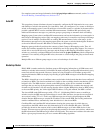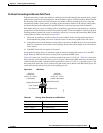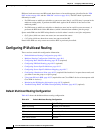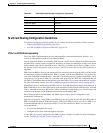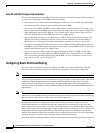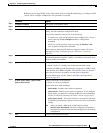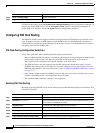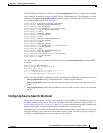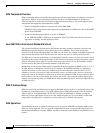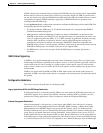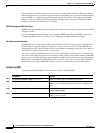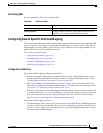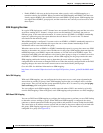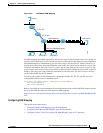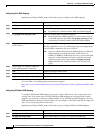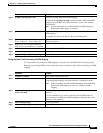
40-14
Cisco ME 3400 Ethernet Access Switch Software Configuration Guide
OL-9639-06
Chapter 40 Configuring IP Multicast Routing
Configuring IP Multicast Routing
SSM Components Overview
SSM is a datagram delivery model that best supports one-to-many applications, also known as broadcast
applications. SSM is a core networking technology for the Cisco implementation of IP multicast
solutions targeted for audio and video broadcast application environments. The switch supports these
components that support the implementation of SSM:
• Protocol independent multicast source-specific mode (PIM-SSM)
PIM-SSM is the routing protocol that supports the implementation of SSM and is derived from PIM
sparse mode (PIM-SM).
• Internet Group Management Protocol version 3 (IGMPv3)
To run SSM with IGMPv3, SSM must be supported in the Cisco IOS router, the host where the
application is running, and the application itself.
How SSM Differs from Internet Standard Multicast
The current IP multicast infrastructure in the Internet and many enterprise intranets is based on the
PIM-SM protocol and Multicast Source Discovery Protocol (MSDP). These protocols have the
limitations of the Internet Standard Multicast (ISM) service model. For example, with ISM, the network
must maintain knowledge about which hosts in the network are actively sending multicast traffic.
The ISM service consists of the delivery of IP datagrams from any source to a group of receivers called
the multicast host group. The datagram traffic for the multicast host group consists of datagrams with an
arbitrary IP unicast source address S and the multicast group address G as the IP destination address.
Systems receive this traffic by becoming members of the host group.
Membership in a host group simply requires signalling the host group through IGMP version 1, 2, or 3.
In SSM, delivery of datagrams is based on (S, G) channels. In both SSM and ISM, no signalling is
required to become a source. However, in SSM, receivers must subscribe or unsubscribe to (S, G)
channels to receive or not receive traffic from specific sources. In other words, receivers can receive
traffic only from (S, G) channels to which they are subscribed, whereas in ISM, receivers need not know
the IP addresses of sources from which they receive their traffic. The proposed standard approach for
channel subscription signalling use IGMP include mode membership reports, which are supported only
in IGMP version 3.
SSM IP Address Range
SSM can coexist with the ISM service by applying the SSM delivery model to a configured subset of the
IP multicast group address range. Cisco IOS software allows SSM configuration for the IP multicast
address range of 224.0.0.0 through 239.255.255.255. When an SSM range is defined, existing IP
multicast receiver applications do not receive any traffic when they try to use an address in the SSM
range (unless the application is modified to use an explicit (S, G) channel subscription).
SSM Operations
An established network, in which IP multicast service is based on PIM-SM, can support SSM services.
SSM can also be deployed alone in a network without the full range of protocols that are required for
interdomain PIM-SM (for example, MSDP, Auto-RP, or bootstrap router [BSR]) if only SSM service is
needed.



